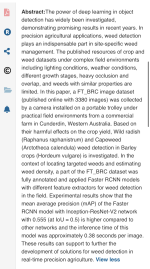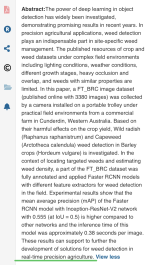Don’t think anyone has gone down this rabbit hole yet? I looked into the DSTG Women in STEM Award - specifically what her paper was about
I couldn’t actually find the paper that the won the award -
An energy-efficient AkidaNet for morphologically similar weeds and crops recognition at the Edge' (co-authors Kevin Tsiknos, Kristofor Carlson, Selam Ahder, but another one that lead to the outputs below
My search lead me to the Australian company
Photonic Group
PATENTED TECHNOLOGY TO DISTINGUISH ONE OBJECT FROM ANOTHER.
Our patented technology seeks to mimic the human eye as a mechanism for distinguishing one object from another in real time by using spectral reflectance data (colour) as well as images (shape) as a combined differentiator.
AGRICULTURAL SPRAYING – DIFFERENTIATE BETWEEN PLANTS AND WEEDS IN REAL TIME.
Commercially, the Group is currently focused on deploying the technology within the agricultural sector where the accurate real time differentiation of one green plant from another has substantial commercial implications in terms of the reduction in herbicide application following the ability to distinguish one plant as desirable crop and not spray it, and another as an undesirable weed and to spray that plant in isolation.
View attachment 25827
View attachment 25826
The power of deep learning in object detection has widely been investigated, demonstrating promising results in recent years. In precision agricultural applications, weed detection plays an indispensable part in site-specific weed management. The published resources of crop and weed datasets...

ieeexplore.ieee.org
View attachment 25816
View attachment 25829
View attachment 25819
View attachment 25823
View attachment 25821
WHAT WE DO.
PATENTED TECHNOLOGY TO DISTINGUISH ONE OBJECT FROM ANOTHER.
Our patented technology seeks to mimic the human eye as a mechanism for distinguishing one object from another in real time by using spectral reflectance data (colour) as well as images (shape) as a combined differentiator.
AGRICULTURAL SPRAYING – DIFFERENTIATE BETWEEN PLANTS AND WEEDS IN REAL TIME.
Commercially, the Group is currently focused on deploying the technology within the agricultural sector where the accurate real time differentiation of one green plant from another has substantial commercial implications in terms of the reduction in herbicide application following the ability to distinguish one plant as desirable crop and not spray it, and another as an undesirable weed and to spray that plant in isolation.
OTHER APPLICATIONS.
Our patent families encompass object differentiation using size, shape and colour, and accordingly we are of the opinion that this technology now truly does mimic the human eye and as such ,
the technology has broad application in a multitude of commercial scenarios, some of which are described in accompanying pages. However, we acknowledges that the number of potential applications for this new technology are vast and should anyone believe that our technology has particular application in some specific field or endeavour or would like to explore how our technology could be used or deployed in the future, either in isolation or teamed with some other technology, we would encourage that person to contact is to further discuss and evaluate the concept.
WHO WE ARE
The purpose behind the formation of the Photonic Group was to determine if it was possible to create an automated detection system that used light to distinguish one plant from another.
Since that time, the Group has made several key discoveries leading to the lodgement of various patent families in various countries, including Australia, Canada, USA, and Europe.
In 2017, the Group realised that real-time identification using only one discrimination mechanism (spectral reflectance) did not, of it itself, allow for the requisite discrimination in all instances encountered, so a decision was made to identify a suitable complimentary detection technology that could be combined or hybridised with spectral reflectance to generate superior discrimination rates.
Imaging technology was found to be the best complementary technology and the system now developed uses a combination of image data and spectral reflectance data, collected simultaneously, with both data streams being blended and ultimately analysed via the application of artificial intelligence in our proprietary neural net.
Selective spraying using Photonic Group detection
As a result of the work done, the Group has determined that the generation of spectral reflectance data by illuminating a target with a selection of specific laser wavelengths and the collection and
analysis of that spectral reflectance data in real time, combined with image data collected at the same time does indeed enable the detection unit to distinguish one plant from another.
Having distinguished one plant from another, the system can then be programmed to make a range of decisions – within an agricultural environment, these decisions are typically Spray Plant A, ignore all other plants, or ignore Plant A, spray everything else,
however, once the identification is made, the decisions and actions following from that identification are totally contained with the system programming.
As the US Marines have observed – “If you can see a target, you can hit it, and if you can hit it, you can kill it.”
Real time identification & spraying
The initial step is the most difficult – the seeing of the target –
what our detection unit does is provide a substitute for the human eye (but is not limited to the human eye limitations in terms of only using the visible light portion of the entire electromagnetic spectrum) to identify a target in real time. Once that identification is made, decisions and actions will follow, subject only to the pre-programmed instructions of the system.
View attachment 25820
A TECHNOLOGICAL BREAKTHROUGH
The recently developed discrimination sensor has been termed the ‘Missing Link in Precision Agriculture’ and as such represents the future of real time weed / crop discrimination.
At its most basic it is a system that provides a farmer with
real time discrimination between differing types of vegetation, typically discriminating between crop and weed.
The demand for such a system within the precision agricultural arena has been high, predominantly because of the costly outlay arising from the current practice of blanket spraying of pre and post emergent weeds; a practice that is now universally recognised as being highly inefficient, expensive and hazardous to both human and environmental health.
Another potential usage within agriculture is dealing with those weeds that are starting to show resistance to any herbicide applied in a blanket pre-emergent spray.
Because the herbicide applied using the Group’s technology is used precisely and sparingly, a second spray run can be done in the weeks following a blanket spray, and where viable plants (i.e. those starting to develop resistance to the herbicide used as a blanket spray) are detected, those plants can be re-sprayed using a more expensive, but more effective herbicide, thus eliminating from the farm’s seed bank any weeds developing resistance to the blanket spray herbicide
Furthermore, because the decision to turn on a spray nozzle is made in real-time, the precise location of where that nozzle is activated can be recorded by the technology, leading to the generation of ‘paddock maps’ showing the precise location and numbers of activation in a given area.
Should this information be passed back to a central location, then, at the farm level, analysis of the paddock maps over time, will allow farmers to see the impact their spraying program, identify the direction of and speed of spread of any invading weed, etc.
Analysis of multiple farms in the same region, will inevitably lead in better regional agronomic information regarding the control of weeds across multiple farming properties.
HOW DOES IT WORK? (UNIT LEVEL)
Each detection unit currently contains three lasers projecting light at three discrete and highly optimised wavelengths.
These lasers are sequentially switched on with each pulse of light passing through an optical cavity that generates multiple beams from each laser source. A linear photo detector imager records the intensities of the laser light reflected off any plants within view.
Simultaneously, a camera takes a series of images and both the spectral reflectance data and the image data are combined with an on-board controller circuit then using both data streams, calculates the signature and compares that signature to signatures stored in a database.
Should the signature match the profile of a pre-recorded weed in the database, the system generates a ‘positive strike’ signal that then results in a positive action occurring, such as a spray nozzle being activated and the weed being sprayed, or the position of the weed being logged using a d GPS system.
HOW DOES IT WORK? (SYSTEM LEVEL)
Each detection unit covers a detection field of 500mm. Multiple detection units are mounted on a vehicle side by side to achieve the desired detection swathe – i.e. 4 units provide 2 metres coverage.
The vehicle is then driven forward at a relatively constant speed such that the units traverse and interrogate the terrain. Sensors detect the reflected laser intensities from the ground and vegetation, whilst images are being generated. The electronic system then processes the recorded data.
Once a target weed is detected a ‘positive strike’ signal is generated to activate a nozzle and spray the weed, or to log its precise position, or both.
If spraying is the selected outcome arising from a positive strike; because the distance between any individual detection unit and its associated spray nozzle is known absolutely and because the speed of the vehicle at that particular instant of time is also known, the system allows for an appropriate delay before activating the spray nozzle so that the spray nozzle is only activated immediately in front of the weed.
These factors then allow the spray nozzle to remain open only whilst it is positioned above the weed and once the detection unit determines that it has transited the weed, it turns off the spray nozzle.
In this way, that which is sprayed out of the spray nozzle is only sprayed immediately before the detected weed, across the detected weed and turned off immediately after the weed ceases to be detected – in this way,
herbicide is precisely applied, minimising the volume of herbicide used per square metre and minimising the deleterious effects of excess herbicide coverage on the crop, on the soil and generally on the environment.
Because the herbicide is being applied so precisely, it is possible to envisage the Group’s sensor platform being used in row cropping scenarios, such as cotton, sugar-cane and similar, where the technology actually detects and sprays undesirable plants within the actual row, and not just in the area between rows.
FUTURISTIC
Several technologies are now converging and one possible future within the agricultural sector would be the creation of a multiplicity of small, ground based, autonomous (or semi-autonomous) weeding devices, bearing a considerable likeness to domestic semi-autonomous vacuum cleaners.
These devices would, over time, map a particular area and / or have specified coordinates within which they operate on a 24 / 7 basis. Each device would be equipped with a Photonic Group sensor and would ‘patrol’ a broad-acre paddock or similar, constantly looking for plants that are designated as undesirable at that location (canola plants might not be regarded as undesirable, unless they were found in a field of barley, for example).
Once detected, the device could deploy one of many possible mechanisms to eradicate the undesirable plant that do NOT involve herbicides at all.
For example, the plant could be mechanically removed, the device could be fitted with solar cells and generate boiling water, position itself over the plant and generate a high voltage discharge, generate a flame, etc. All these measures do NOT involve herbicide as a killing mechanism, and all are far more environmentally friendly than continually applying increasingly more expensive herbicides.
As an interim measure to that future, the device could carry one or more herbicides, selecting which one to use based on prior logged activity, and could be programmed to return to a base station as its energy supply, or any of its payload herbicides ran low.
All instances of any intervention could be reported to a central information repository, allowing for real time analysis of activities undertaken to eradicate undesirable plants, in terms of location, frequency, and the like.
This environmentally friendly scenario ultimately rests on the ability of a machine to recognize ‘friend’ or ‘foe’ in real time.
The Photonic Group sensor platform is designed to allow machines to make this decision and once the decision is made, the consequences and down-stream outcomes of that decision can be readily programmed into the system.








